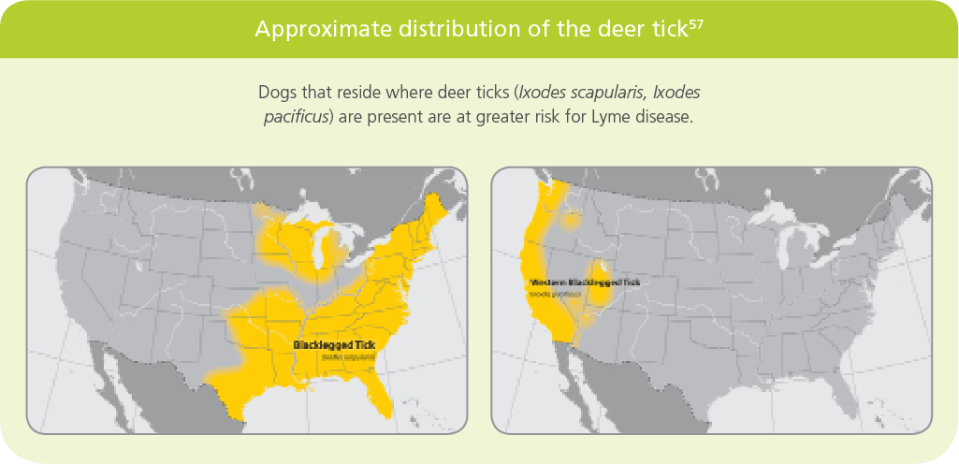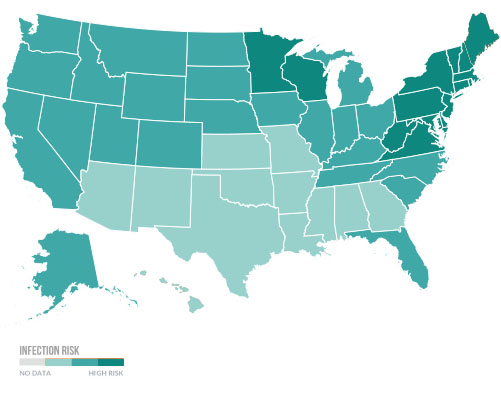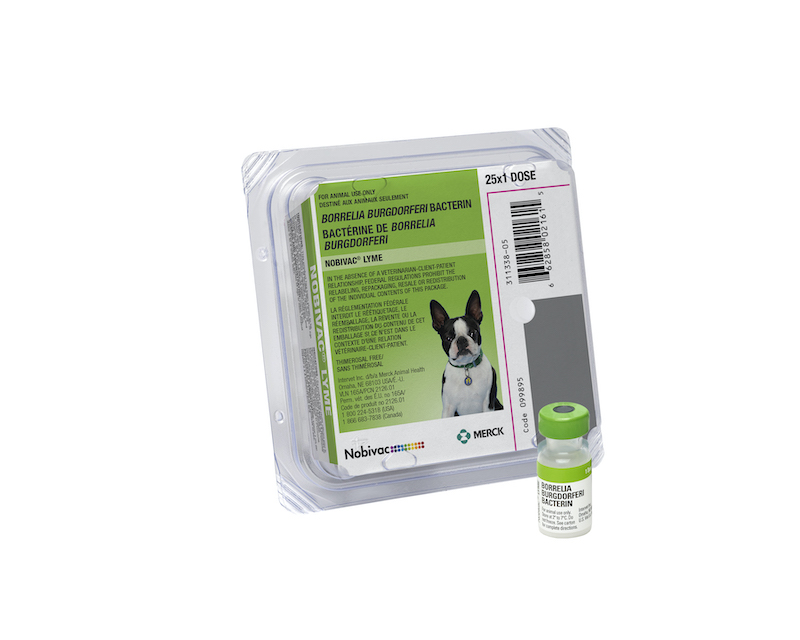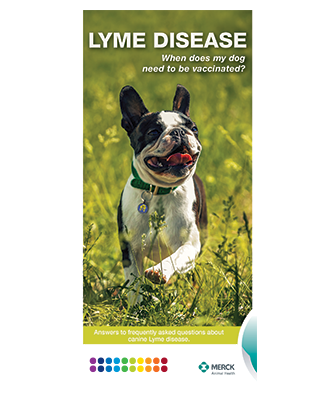

Canine Lyme Disease
There’s an increase in ticks, and tick-related diseases, with the number of reported tickborne diseases more than doubling in the last 13 years.81
Disease Overview
Lyme disease is a bacterial infection transmitted by ticks to dogs, other animals and people.
Most Lyme disease in the United States is spread by deer ticks and is found primarily in the Northeast, Southeast and upper Midwest. The western black-legged tick is the primary cause of Lyme disease transmission in the western states.
LYME DISEASE FAST FACTS
- Ticks that can transmit Lyme disease have expanded their geographic range and are now being found in places they weren’t seen 20 years ago82
- The number of counties in the US considered to be high risk for Lyme disease has increased by 320% since the 1990s82
- CAPC data shows nationwide, dogs are being exposed to Lyme disease outside of traditionally endemic areas54
- Approximately 75% of unvaccinated dogs in endemic areas will eventually test positive for Lyme disease55
- The best way to protect dogs is year-round flea and tick control and vaccinating those dogs that visit or live in endemic areas56

U.S. Canine Lyme Disease Prevalence83

TRANSMISSION
Lyme disease is transmitted by Ixodes spp. ticks, commonly called deer ticks. The ticks carry the bacterial cause of Lyme disease, Borrelia burgdorferi. After attaching to a dog, a tick takes a blood meal which stimulates the B. burgdorferi in the midgut of the tick to change their outer surface protein from Osp A (outer surface protein A) to Osp C. This outer surface protein change enables the bacterium to move into the tick’s salivary glands where it can be injected into the dog’s bloodstream. Once in the bloodstream the organism is carried to multiple locations including the joints.
CLINICAL SIGNS
- Arthritis
- Lameness
- Fever
- Anorexia
- Fatigue
DOGS AT RISK
- Lyme disease was traditionally thought to be limited primarily to the Northeastern region of the U.S. where deer populations were most dense. However, the warming weather and migration of the white-tail deer have caused the spread of the tick populations. Because of this, Lyme disease is now prevalent in the majority of the U.S., increasing the number of dogs at risk.
- With the increase in dog travel to Lyme endemic areas, more dogs are at risk. Positive cases of canine Lyme disease have been reported across the U.S., with 39 states now reporting high and moderately high prevalence of canine Lyme disease.
- Dogs at increased risk for Lyme disease include:
- Active dogs that walk or hike in the woods
- Dogs that play in fields
- Dogs that spend time in the yard
MORBIDITY THREATS
Most commonly, dogs may present with fever, shifting leg lameness, swollen joints, enlarged lymph nodes, lethargy, depression and anorexia.
Less commonly, dogs will develop a protein losing nephropathy that can result in hypoalbuminemia, edema and eventually renal failure, which is known as Lyme nephritis.
SPREADING DISEASE
- Infection occurs 24-48 hours after the tick attaches to a host when
B. burgdoeri is passed through the salivary glands of an infected tick into the animal.84 - Once the animal is infected with spirochetes from the tick, the spirochetes spread through connective tissue and may result in infections in the joints, heart, and neural tissue.84
DIAGNOSIS
Diagnosis is based on history, clinical signs, elimination of other diagnoses, laboratory data, epidemiologic considerations, and response to antibiotic therapy. Mixed infections should be considered when clinical signs are apparent.
Long incubation periods, persistence of antibodies for months to years, and the disassociation of the antibody response from the clinical stage of disease make diagnosis by blood testing alone impossible.
Merck Animal Health Vaccines

NOBIVAC® LYME
Two inactivated isolates of Borrelia burgdorferi initiate the production of borreliacidal antibodies against OspA and OspC. (add references 1,5,80) Shown to be effective against Borrellia burgdorferi and subclinical arthritis caused by Borrelia burgdorferi.
Professional Resources and Educational Materials
Keep your clinic and staff informed and aware of diseases and outbreaks.

Lyme Disease Pet Parent Guide
Brochure
Share this printable brochure to educate pet parents about their dog’s risk for Canine Lyme Disease.

Absolutely Conserved – The Antibody Response That Counts
Video
Learn how Nobivac® Lyme targets a conserved region of Borellia burgdorferi

Adjuvant This – Why Adjuvants Are Necessary
Video
Learn why adjuvants are used to bolster the immune response
No items to show.
TECHNICAL ASSISTANCE
For technical assistance or to report a suspected adverse drug reaction, contact Merck Animal Health at 1-800-224-5318
References:
54. https://wwwnc.cdc.gov/eid/article/21/8/pdfs/14-1878.pdf. Accessed July 26, 2018. https://wwwnc.cdc.gov/eid/article/21/8/pdfs/14-1878.pdf. Accessed July 26, 2018.
55. http://www.petsandparasites.org/parasite-prevalence-maps#2018/all/lyme-disease/dog/united-states/. Accessed July 26, 2018.
56. AAHA Canine Vaccination Guidelines (Revised 2017). https://www.aaha.org/guidelines/canine_vaccination_guidelines/practice_vaccination.aspx. Accessed July 26, 2018.
57. Centers for Disease Control and Prevention. Ticks: Geographic distribution. Available at: http://www.cdc.gov/ticks/geographic_distribution.html. Accessed October 14, 2013.
78. Companion Animal Parasite Council. Lyme Disease, Dog. Available at: https://capcvet.org/guidelines/lyme-disease/ Accessed March 29, 2019.
81. Dogs continue to be at an elevated risk of heartworm disease and lyme disease in 2018. http://www.petsandparasites.org/expert-insights/dogs-continue-tobe-at-an-elevated-risk-of-heartworm-disease-and-lyme-disea/. Accessed August 2, 2018.
82. https://www.cdc.gov/media/dpk/diseases-and-conditions/lyme-disease/index.html. Accessed July 26, 2018.
83. Companion Animal Parasite Council. http://www.petsandparasites.org/parasite-prevalence-maps/#2018/all/lyme-disease/dog/united-states/. Accessed September 29, 2018.
84. Overview Of Lyme Borreliosis – Generalized Conditions https://www.merckvetmanual.com/generalized-conditions/lyme-borreliosis/overview-of-lyme-borreliosis. Accessed August 3, 2019.

